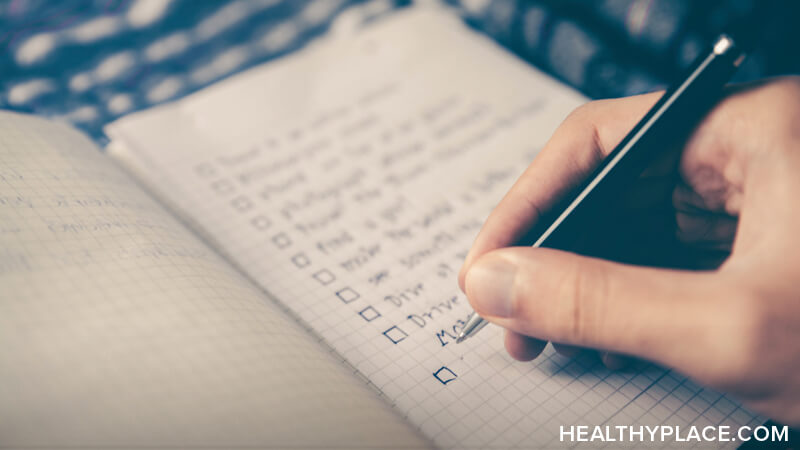A Checklist for Your Anxiety for Mental Health Awareness Month

Here's an anxiety checklist that can help you define your relationship with anxiety. A big part of Mental Health Awareness Month, currently in full swing, is increasing understanding of all things mental health. This includes your own relationship with anxiety. It's useful to know what anxiety is, especially if you're experiencing uncomfortable symptoms but don't know if they are related to anxiety. You can use the below anxiety checklist to better understand your anxiety and then to strengthen your mental health.
When you embrace the spirit of Mental Health Awareness Month and its spirit of understanding, you take a step away from anxiety and toward wellbeing and freedom. Take your understanding of anxiety, add your mental health goals, and create a plan for changing your relationship with anxiety.
An Anxiety Checklist for Mental Health Awareness Month
This anxiety checklist will guide you in forming a clear and specific description of your unique anxiety. Think about how you experience anxiety, and mentally check what resonates with you. Read through the checklist to develop more awareness of how you experience anxiety. If you have symptoms not on the list write them down to address them later.
- I get frequent headaches when I worry about something or someone.
- I have stomachaches with my anxiety.
- When I am worried or afraid, I start to sweat.
- My skin shows anxiety with hives or other rashes.
- When my anxiety flares, I feel nauseated.
- I have digestive troubles that are unrelated to what I eat.
- If I'm in a place that heightens my anxiety, my vision becomes blurry at times.
- I can't enjoy good relationships I'm preoccupied with fears about them.
- I don't practice self-care because I can't relax and get into what I'm doing.
- Sometimes I can't get out of bed because of a deep sense of dread.
- I've cried because of my anxiety.
- I've yelled at people because of my anxiety.
- Anxiety makes me feel trapped and miserable.
- I'm tired much of the time.
- It can seem like all of my thoughts are anxious ones.
- Worrying about my anxiety symptoms makes them worse.
- I know what people are thinking about me and it's bad.
- I've thought about giving up driving because of the anxiety I feel behind the wheel.
- Anxiety has limited my life.
- I feel like anxiety affects how I talk to people and it's embarrassing.
- I have trouble making decisions because my anxious thoughts get in the way.
- I'm not doing as well as I used to at school or work because of my worries.
Whether one item is getting in your way or all of them are disrupting your quality life, you can take yourself in a different direction and leave anxiety behind.
Mental Health Awareness: Understand How to Reduce Your Anxiety
With a clear understanding of your anxiety, you can create a targeted plan to reduce it. How you make your anti-anxiety action plan will depend on your checklist. Look for patterns. For example, do you tend to experience more anxious thoughts than emotions or are they equal? Where do physical symptoms fit in? Is anxiety limiting you, or is it more of an annoyance than a restriction?
Revisit the checklist. Choose one or two things as a starting point for your action. Chipping away at your anxiety step by methodical step is more effective than using a jackhammer to blast anxiety to smithereens. That would be messy, likely painful, and it wouldn't work.
With heightened mental health awareness, you can devise your personal anxiety-beating plan.
- Select your one or two anxiety symptoms.
- Create a goal. What do you want? Why? What will your life be like when you meet your goal?
- Brainstorm ways you can reduce your anxiety. Mindfulness, meditation, self-help books, seeing a therapist, exercise, eating healthy, staying hydrated with water, finding humor, and many other activities reduce anxiety. Pick anxiety-reducing methods related to your symptoms.
- Start anywhere that fits you. Dig into your worst symptom or start with what you think will be the easiest so you find early success.
Use Mental Health Awareness Month as a catalyst to an understanding of your own anxiety. The more aware you are of how anxiety affects you, the better you'll be able to overcome it with a symptom-specific plan of action.
APA Reference
Peterson, T.
(2019, May 16). A Checklist for Your Anxiety for Mental Health Awareness Month, HealthyPlace. Retrieved
on 2025, December 22 from https://www.healthyplace.com/blogs/anxiety-schmanxiety/2019/5/a-checklist-for-your-anxiety-for-mental-health-awareness-month
Author: Tanya J. Peterson, MS, NCC, DAIS
This is a great checklist. Sometimes you can get confused about how you feel and lose control.
I don't know if it's okay but I want to share some helpful resources: https://thirdage.com/condition/anxiety-3/ This is a very detailed article on anxiety.